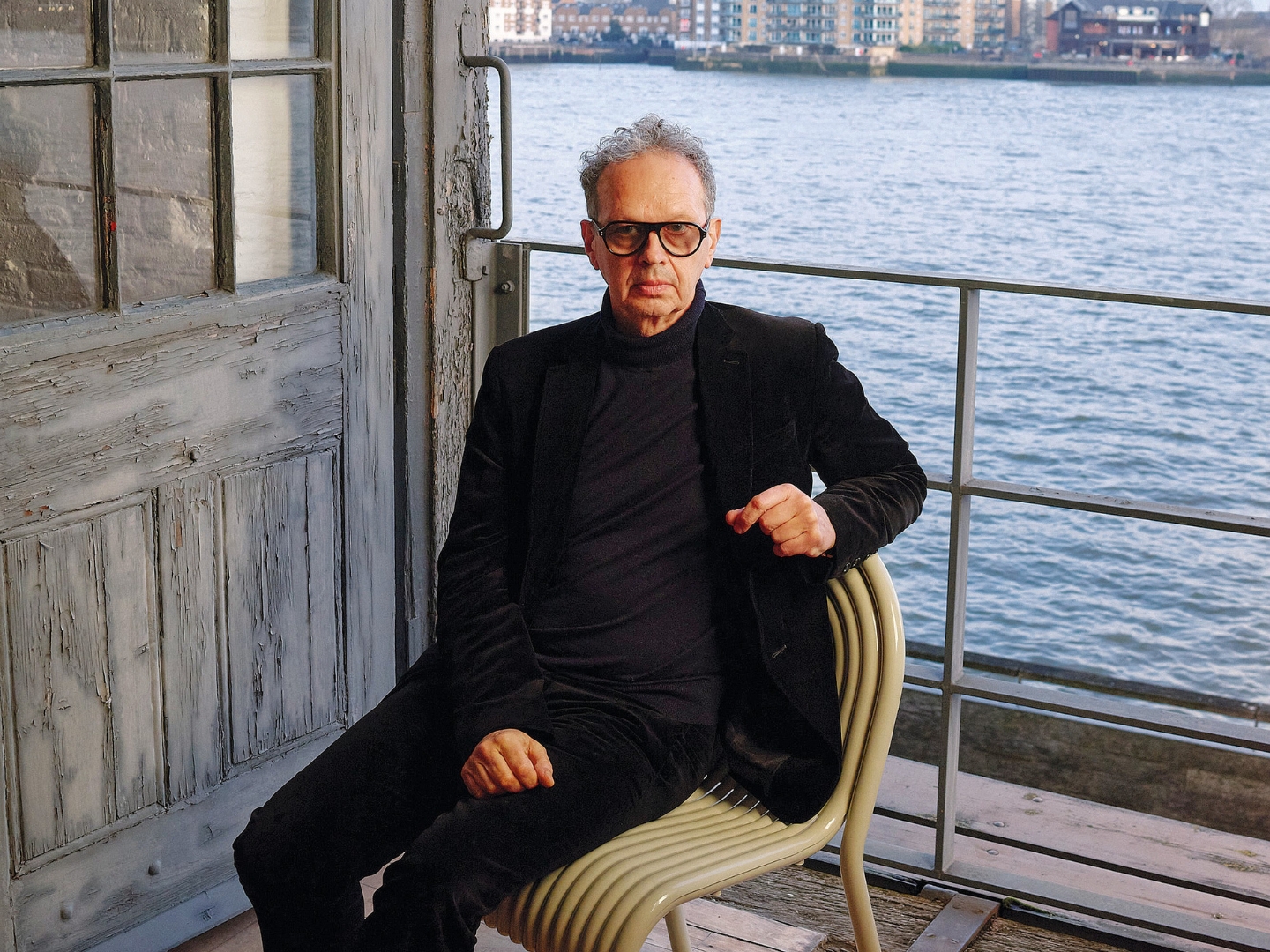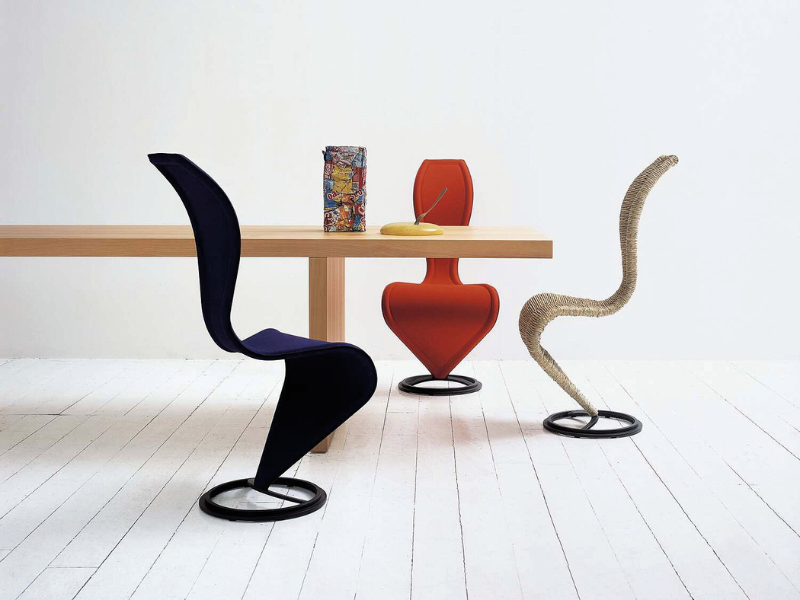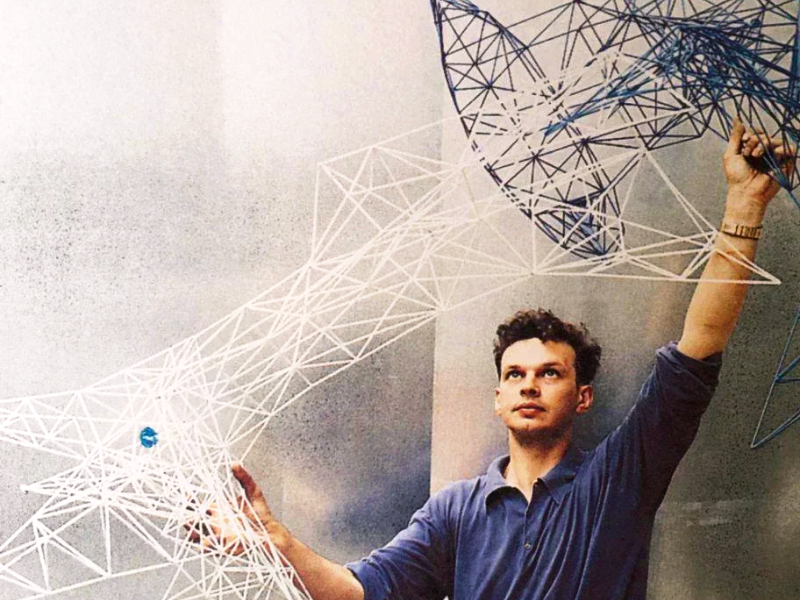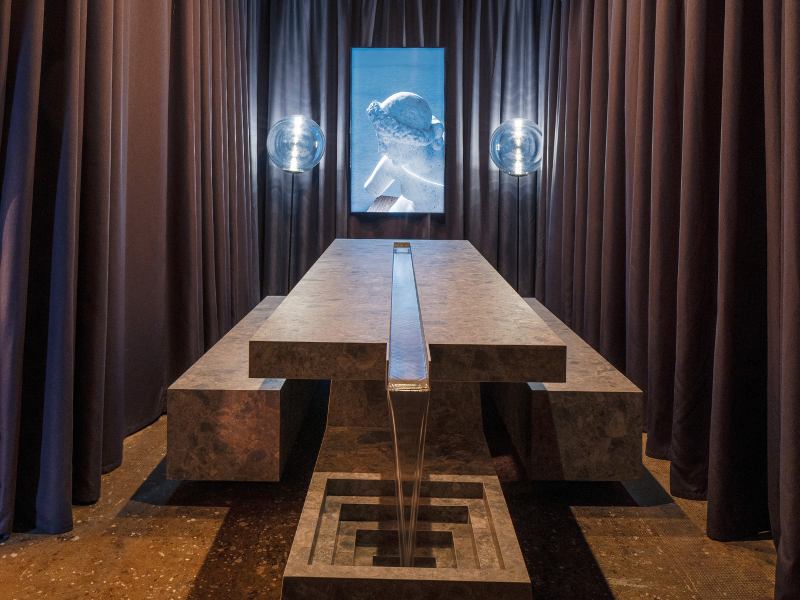
Seated atop the Groove armchair, part of his first outdoor collection, Tom Dixon is one of the furniture industry's most revered figures (Photo: Tom Dixon)
The bane of any designer is falling out of style. An object is made and set upon the tumultuous, crashing river that is fleeting trends and fickle consumer tastes, forced to defend itself or be washed away into obscurity. It is therefore the hallmark of a true great to be able to craft something original and enduring, which cuts through the current and carves out its own place in history. British designer Tom Dixon, the mastermind beloved for his bold, dynamic and undeniably quirky furniture, is one such great.
The 66-year-old, who just celebrated his birthday last month, is revered as one of the most prominent industry figures in the world, with his works being displayed in such prestigious venues as the Victoria and Albert Museum in London and the Metropolitan Museum of Art in New York. And yet, he says with a shrug: “I still don’t see myself as a particularly effective designer. I do things more like a sculptor.” Asked how he has evolved over the decades, he admits, “Half the fight is trying to remain naive.”
There is poetry to how his unfailing love for the new makes his designs so adept at transcending time — famous collections like the conical Pose lamps, rounded Fat chairs and vase-like Beat fixtures illustrate a perennial yet contemporary charm.
Well seasoned, no doubt, by hundreds of interviews, the smartly dressed Englishman still carries an aura of sincerity and candour about him, a veteran as fully equipped with entrepreneurial insight as he is with a pure, unadulterated love for making. He speaks on engaging with the production process from start to finish, what draws him to his mediums of choice and the rising issue of sustainability in the furniture business.
The school of life
Born in Tunisia in 1959, Dixon remembers little of his family’s movements around North Africa. Prevailing memories from his early years are of animals and food. “I think anybody who travels a lot at that age gets a different perspective on the world, an alternative lens to look at things. All of these end up feeding into your creativity,” he reflects. Being raised by a French mother and English father offered him a second language and culture to perceive life through, and he credits this background as a base for his later artistic impulses.
After the age of four, Dixon returned to the UK and later attended Holland Park School in West London, a comprehensive school he jokingly describes as “a kind of failing city centre experiment in education”. But for its “less than brilliant” academic reputation, the institution did have the advantage of providing various workshops where the lad was taught woodworking, ceramics and technical drawing. “I got this grounding in a variety of techniques quite young at 16. When I entered [the Chelsea College of Arts] and was supposed to do a foundation course, I thought I’d find my tribe — loads of people who were super creative — but what I realised was that I really wanted to go out and work in the real world.”
Dixon did not have to wait long. A serendipitous (if not painful) motorbike accident halfway into his first year saw him hospitalised, yanking the maverick from his studies and tossing him into the world of music, playing the bass for the band Funkapolitan in the 1980s. It was not until a second accident, getting into the nightclub business and finding time to scavenge for scrap metal and weld sculpture-esque pieces of furniture that he would embark on his journey to becoming one of the UK’s most esteemed creatives proper. His iconic S-chair, conceived in 1987, was discovered by Italian design magnate Giulio Cappellini, whose company has been manufacturing the item since 1991. From there, the young wave-making Brit soon found the mantle of “furniture designer” lowering quickly and fatefully upon him, something he never foresaw happening.
s_chair.png

“There’s that phrase, ‘You make your own luck’. When you’re interested and dabble in a lot of things, eventually they come back and become a kind of platform for you to create something beyond what you started out trying to do,” he remarks on his long career, from becoming creative director at British homeware company Habitat in 1998 to establishing his own brand in 2002. “All of my experiences in music and graphics ended up being the things that made me what I am now.”
Unlike some artists who view their domain as ending where logistics like fabrication or marketing begin, Dixon has always maintained a holistic and entrepreneurial approach to his work. “If you’re churning out design objects seeing it through means putting it into production and global distribution — being concerned not only about the form or function but also what they’re made from, packaging and communication. It’s just as fascinating to synthesise the strategy as it is to think of the shape of a thing.”
Curiosity and autonomy have been the long-standing cornerstones of his motivations. “There was something very nice about being able to have the whole chain of events unfold from the beginning, all in my own realm, as it were. I think I only became a designer because people were prepared to buy the things I was making for my own pleasure. That direct relationship with the customer gave me confidence to make more,” he explains. He notes further how the experience of someone else putting value on your works is not often afforded in school settings.
It is hard to tell what would have happened if he had gone through the academic pipeline. “When I go and teach, what’s clear is some people need the input, discipline or platform that a school provides. Others are kind of battling it, and would be better outside. I don’t think you can have one prescription,” the self-taught professional muses. “It might well have put me off. I might not have got into music and had a lot of the experiences I had working. Those were quite formative.”
Material man
globular.png

This craving for immediacy also bled into his medium of choice: metal. “Welding definitely suited my impatience,” says Dixon. Far from his current process, where items must undergo multiple revisions and prototypes, there was a fantastic appeal to steel’s malleability and versatility that endeared itself to a young artist endeavouring to learn the craft without needing to worry about cost or getting it right the first time. “Even if you cut it, you can stick it back together in a way that you can’t do with wood or ceramics, you know? If something goes wrong in the kiln, you have to start all over again. Metal is not like that. It really allows you to adapt and add and subtract in a very different way.”
His ability to find this metaphorical fluidity in the solid can be gleaned from his most popular collections — the Melt pendant lights, which celebrate their 10th anniversary this year, feature gorgeously distorted molten glass spheres with a metallic mirror finish. The material still serves as a muse in his latest products, as the company continues to experiment with different types and properties. The Groove outdoor collection, for example, presents Art Deco-style curves and ridges in premium, corrosion-resistant aluminium. “The world of metal alone is a lifetime of possibilities,” he says fondly.
Alas, there are not too many opportunities to play with fire like he used to these days. “The problem with metal is the health and safety environment we operate in now!” bemoans Dixon with a laugh. “I used to love oxy-acetylene welding kits because they’re explosive and you could cut and braze with the flame. I can’t do that anymore, so we’ve ended up sort of castrated here with a glue gun and some cardboard because I’m not allowed to have gas bottles in the building.”
Ironically, it was through exploring this highly tactile medium that he eventually ventured into working with light. “I started off with something called the Pylon Chair, where I was experimenting with the metal rods you use as filler for the welding process, and I loved how you could make really strong structures that were still quite weightless. I must’ve seen some paper lanterns or something — as kids we always had paper lanterns that were on wire frameworks — so I made some geometric, star-shaped objects and covered them in paper.”
chair.png

Positive responses and continuous demand told Dixon there was something here worth pursuing, and we have those starting customers to thank for the striking lamps and fixtures many now consider synonymous with his label. “I got into it even more as I started to understand all of the possibilities and its transformative capabilities. Light has an impact and effect on the whole room,” he says.
So, where does a Tom Dixon creation begin? He shares his fascination with basic geometry and stacking shapes, which he says is now something of an inside joke. “Whenever we go for factory visits or into workshops, I’d spot these shapes and, almost like Lego, try to piece them together,” a method not unlike finding preexisting bits of metal and attempting to assemble them. “That shortcut of having a form or material that’s already suggesting something, or that you can put together in different ways, is almost like a metaphor for how you do design anyway: plucking ideas from different spheres and existing influences … often that’s where the design happens. For me, at least,” he smiles.
As time goes by
For the visionary to whom predictability is anathema, the trick to staying fresh lies largely in keeping oneself open to the never-before-seen. “I always prefer the new, the unexpected, the chance encounter. When people ask where my favourite restaurant or place to go on holiday is, I find it very difficult to answer because I always like the one I haven’t tried yet,” he offers. Having said that, Dixon does not consider himself an absolutist who refuses to touch what has already been made. “I do revisit things. But finding a way to do something completely exciting is definitely a bigger thrill.” Though he is often dissatisfied with what he has done, the ability to preserve a critical eye when it comes to his own work helps identify how a design can be improved while driving his next big thing.
“It’s funny that actually in furniture, it’s quite rare to rework something. People seem to be striving for the perfect object. If you were in the car or software industry, you’d be constantly trying to upgrade and make better versions. The furniture business doesn’t move quite as fast, but I feel there’s every reason to try again or improve things once you’ve acquired more knowledge,” he affirms.
The slower pace of consumption in the industry lends a unique dimension to the conversation on sustainability, which Dixon is highly concerned about. Unlike businesses such as fashion where customers are prone to making regular, seasonal purchases, or the inherent disposability of plastic food packaging, few would go out of their way to fully revamp their interiors every few months based on what is “in”. Longevity has always been the ideal in this designer’s eyes, a quality exemplified by one of his most treasured family heirlooms — his great-grandmother’s writing desk, an antique from the time of Louis XVI in the late 18th century. “I consider that my potential target — to be able to make something that will last eight or nine generations. I’ve been careful about my material choices so they’re not too obnoxious, and so at least we’re in a field that has slightly less detrimental aspects to the planet than a lot of other professions.”
5.png

Recent forays into materials like cork, which has a carbon positive and regenerative effect on the planet, or rediscovering resources like mycelium which has been long neglected, are among the efforts being made by the company and industry to foster a more environmentally conscious culture. “We’re increasingly interested in things that can add and put back, but it’s very hard to think of yourselves as sustainable when you’re producing objects all the time that you’re encouraging people to buy,” he says. “Our trials have also been in giving longer guarantees. For instance, I was playing with this idea of a thousand-year guarantee on objects we can make with a superior material quality.” He has also collaborated with other sustainability pioneers like Spanish luxury surface brand Cosentino to create the Metamorphic installation, a sculptural, angular take on bathroom design, which was exhibited at Milan Design Week 2023.
Beyond the physical, there is a degree of “spiritual” longevity intrinsic to each Tom Dixon that has arguably contributed to his widespread popularity. Shedding the elements which confine something to a trend-based sensibility has always been a priority. But unlike minimalism, which runs the risk of paring things to the bare minimum at the cost of visible functionality, at the core of each piece lies a certain Platonic idealism. “There’s a joy in expressing that soul. I like objects that have an overexpressed lamp-ness or chair-ness about them. It’s trying to balance the idea of reducing to the essentials while retaining a visible understanding of what something is for,” he emphasises.
Doing it himself
At home, Dixon prefers outside influences and things from his travels over turning his pied-à-terre into a showroom. Save for a few projects in progress here and there, he describes his abode as an eclectic mix of other people’s works and inherited artefacts. “There is a cedar wardrobe that my grandmother had made by local Moroccan craftsmen that is very precious to me. The rest are things from the 1960s which I thought was an amazing era for real liberation in terms of how people lived and the colours they used. And then things that I might have picked up from a skip — a piece of marble as a table or whatever I just liked the look of.”
While he adores the cinema of welding and the joy of hunkering down and crafting, Dixon’s own workbench must-have is in fact nothing tangible. “Solitude is underrated. You build these infrastructures and you end up in 100 meetings and a dozen interviews, telling other people what to do instead of inhabiting your own head and hands,” he says. Over the pandemic, he occupied a commercial orchid farm belonging to a friend where he got to create without restrictions or plans. “It’s more the intangibles that become important — light, space, silence. Plus, the raw materials I wasn’t expecting to have, which tended to be bamboo sticks and broken glass and aluminium extrusions from derelict greenhouses, provoked me into being creative again.”
orchid_farm.jpg

Nobody knows what the future holds, and for the renegade who relishes the unknowable, that is a tantalising and terrifying prospect. Economic and cultural shifts over the decades have already made prominent ripples in consumer behaviour. “It’s an odd, disturbing time in history. The way people live now is becoming very challenged in terms of the ownership of apartments,” he comments. On top of the swiftly shrinking sizes of real estate translating into less furniture per capita, where individuals once owned televisions, radios and desktops, the average Joe now needs only a smartphone. There is simply not as much to design overall.
“The lived environment is becoming less and less interesting. What do blended realities mean for objects? Whenever there’s change, there’s opportunity. And the change right now is where people are more concerned about creativity and the digital sphere than their domestic environments,” the veteran notes. He also foresees the design practice becoming increasingly digitally driven as technologies such as 3D printing become more accessible, enabling a deconstructed manufacturing system that he feels will inevitably result from trade barriers and scarcity.
With an international business and a network that comprises so many dealers and customers, there is an expectation for his art to remain the same. The creative instinct to pursue the new runs the risk of neglecting the expectations of your clientele. But it is the unfaltering desire to remain unexpert and adaptable which Dixon refuses to give up.
“There is that quote, ‘May you live in interesting times’. Well, we kind of are, but they’re also scary! There are a lot of possibilities right now, but also huge dangers and complexities. It means we have to be elastic and progressive, and never complacent in the modern world.”
This article first appeared on June 9, 2025 in The Edge Malaysia.


